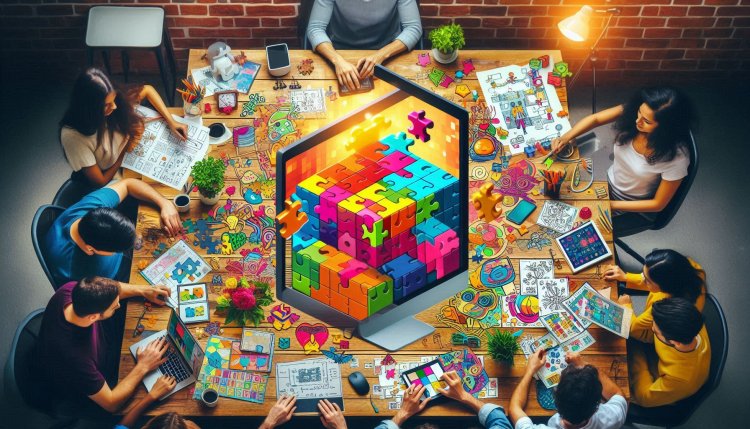Puzzle games have captivated players for decades, from timeless classics like Tetris and Sudoku to modern hits like Portal and Monument Valley
Puzzle games have captivated players for decades, from timeless classics like Tetris and Sudoku to modern hits like Portal and Monument Valley. Their blend of challenge, creativity, and satisfaction makes them a beloved genre.
How to Make Puzzle Games: A Step-by-Step Guide to Captivating Game Development
Craft engaging puzzles, design immersive experiences, and launch your game successfully
Puzzle games have captivated players for decades, from timeless classics like Tetris and Sudoku to modern hits like Portal and Monument Valley. Their blend of challenge, creativity, and satisfaction makes them a beloved genre. If you’re eager to create your own puzzle game, this guide will walk you through the process—from concept to launch—while optimizing for SEO to ensure your game reaches its audience.
Step 1: Understand the Puzzle Game Genre
Before diving into development, research existing puzzle games to identify trends and player preferences. Popular subgenres include:
-
Logic puzzles (e.g., The Witness)
-
Physics-based challenges (e.g., Cut the Rope)
-
Pattern recognition (e.g., Candy Crush Saga)
-
Narrative-driven puzzles (e.g., Return of the Obra Dinn)
Analyze what makes these games successful. Is it their mechanics, storytelling, or visual style? Understanding the market helps you carve a unique niche while avoiding saturated concepts.
Step 2: Define Core Mechanics and Concept
Every great puzzle game hinges on a core mechanic—the central interaction that drives gameplay. Ask yourself:
-
What action will players repeat most (e.g., rotating blocks, connecting dots)?
-
How does this mechanic evolve as the game progresses?
Pair your mechanic with a compelling theme or story. For example, Portal combines physics puzzles with dark humor, while Lumines synchronizes block-matching with music. A unique theme enhances immersion and memorability.

Step 3: Design Engaging Levels and Progression
Level design is the backbone of puzzle games. Follow these principles:
-
Start simple: Teach players the basics before introducing complexity.
-
Gradually increase difficulty: Introduce twists, like time limits or new mechanics, to keep challenges fresh.
-
Avoid frustration: Ensure solutions are logical. Playtest to confirm puzzles are challenging but solvable.
Tools like Miro or Tiled can help map out levels. Aim for a “flow state” where players feel challenged but not overwhelmed.
Step 4: Choose Development Tools and Build a Prototype
Select a game engine that aligns with your skills and vision:
-
Unity: Ideal for 2D/3D games with C# scripting.
-
Unreal Engine: Great for high-fidelity visuals.
-
Godot: A lightweight, open-source option.
-
Construct 3: No-code platform for beginners.
Build a prototype focusing on your core mechanic. Use placeholder art to test functionality. Tools like Aseprite (for pixel art) or Blender (3D models) can later enhance visuals.
Step 5: Test and Iterate Based on Feedback
Playtesting is crucial. Gather a diverse group of testers to:
-
Identify unclear puzzles or unfair difficulty spikes.
-
Assess pacing and engagement.
Use feedback to refine mechanics and level design. Iteration might reveal that a puzzle needs clearer clues or that a mechanic feels repetitive.
Step 6: Polish Visuals, Audio, and Performance
Aesthetic appeal elevates player experience:
-
Art style: Choose a cohesive style, whether minimalist (Monument Valley) or vibrant (Puyo Puyo).
-
Sound design: Use audio cues to signal success/failure. Ambient music can enhance immersion.
-
Optimization: Ensure smooth performance across devices. Reduce load times and fix bugs.

Step 7: Launch and Market Your Game
A successful launch requires strategic marketing:
-
Create a trailer: Highlight unique mechanics and visuals.
-
Leverage social media: Share development updates on Twitter, TikTok, or Instagram.
-
Choose platforms: Target app stores (iOS/Android), Steam, or consoles based on your audience.
-
Engage communities: Post on Reddit (r/puzzlegames) or forums like TIGSource.
Consider a soft launch to gather player feedback before a full release. Post-launch updates with new levels or features can retain players.
Conclusion
Creating a puzzle game blends creativity, technical skill, and player psychology. By researching the genre, refining core mechanics, and iterating through testing, you can craft an experience that challenges and delights. With the right tools and marketing strategy, your game could be the next viral hit. Ready to start? Download a game engine, brainstorm ideas, and let the puzzles take shape!
SEO Tips for Aspiring Developers:
-
Use keywords like “how to make puzzle games,” “puzzle game design,” and “game development tools” in blogs or dev logs.
-
Share behind-the-scenes content to attract organic traffic.
-
Collaborate with gaming influencers for reviews or gameplay videos.
Now, go unlock the puzzle game creator within you—your audience awaits!
What's Your Reaction?



















